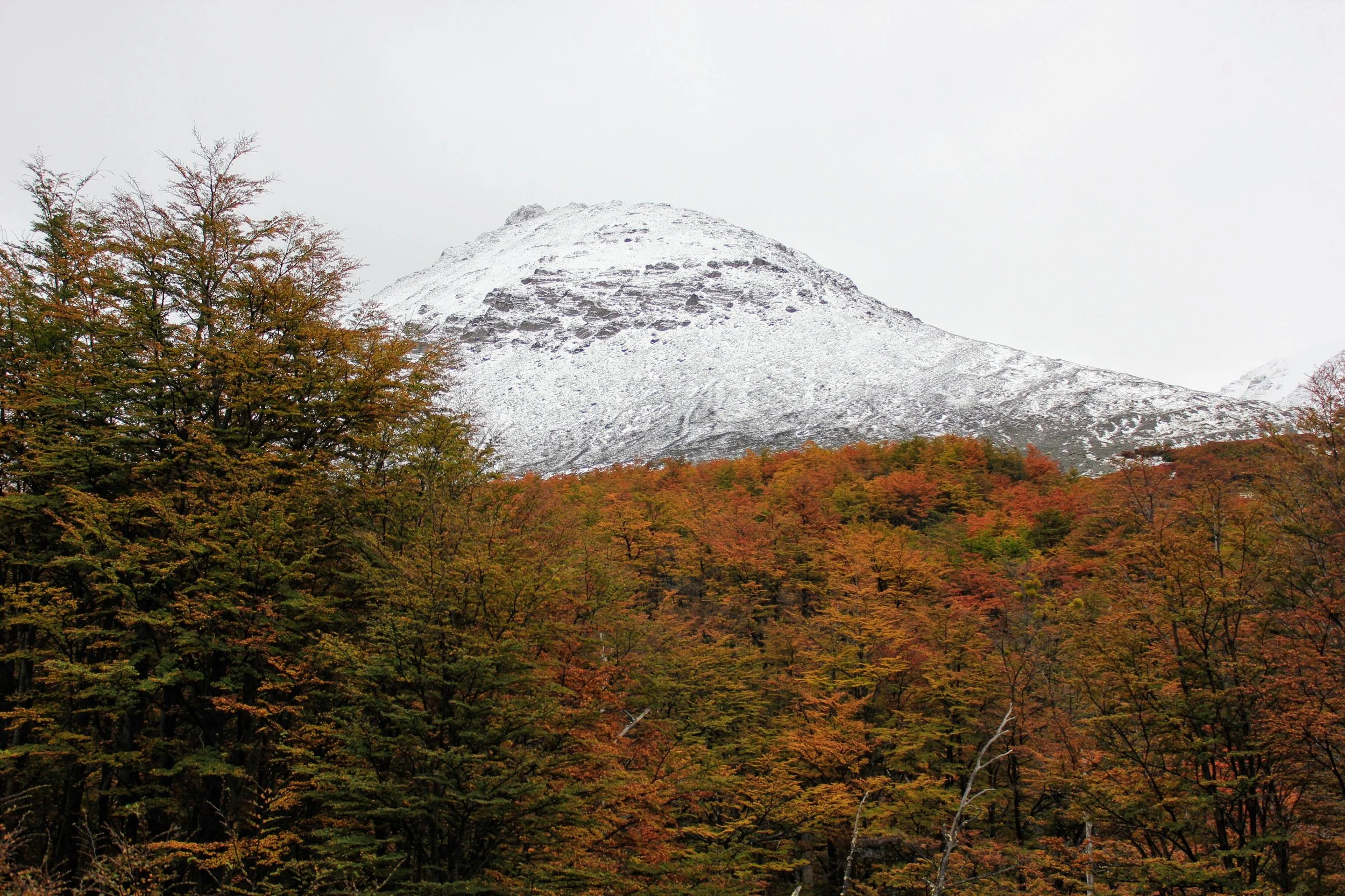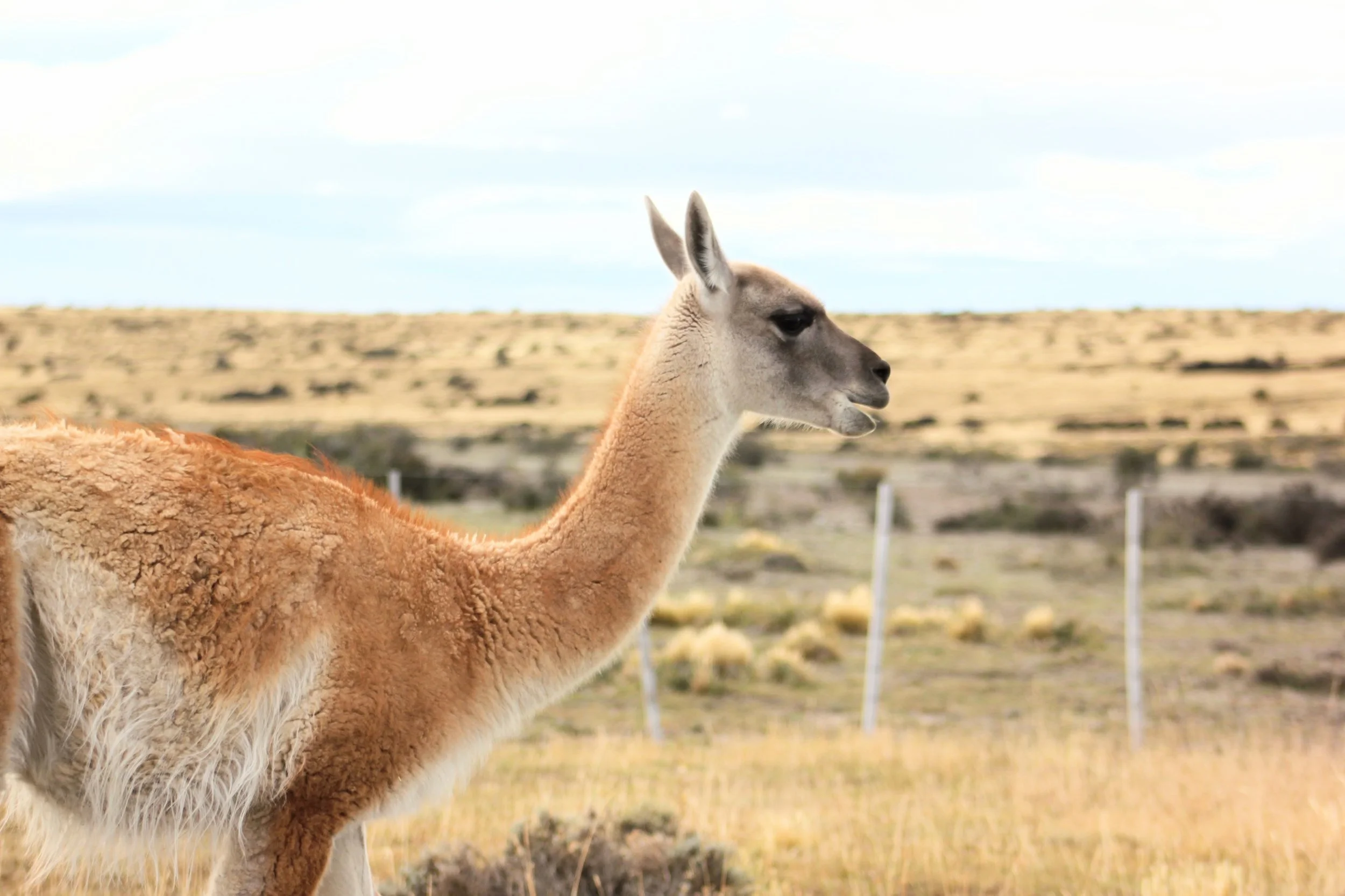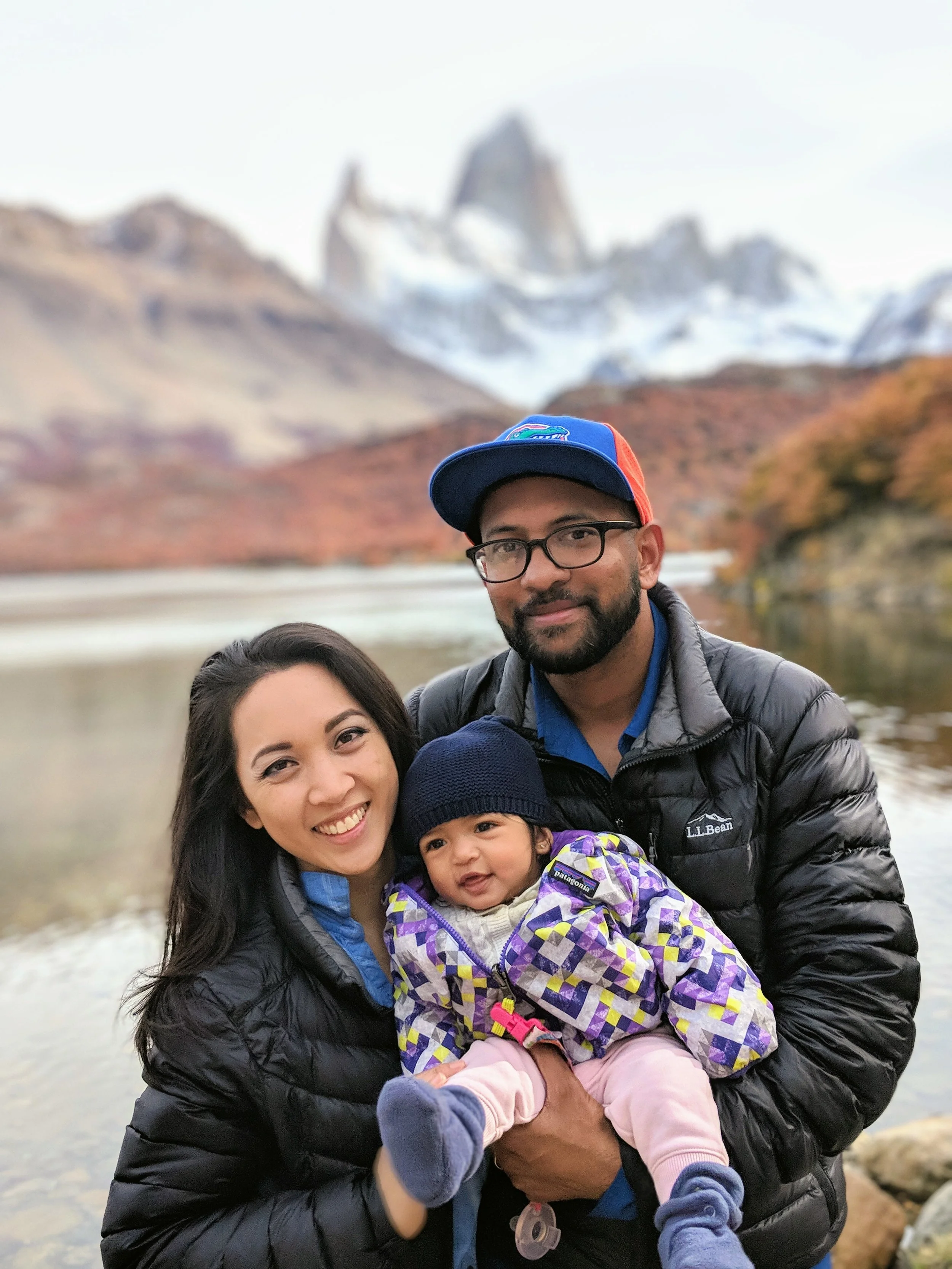Top 8 Things to Do in Patagonia with a Baby [2 Week Itinerary]
If you’re a budget traveler and heading to Patagonia, I have news for you. This place isn’t cheap. We spent a lot of money on meals, tours and transportation. But visiting Patagonia is absolutely worth every penny (or peso). Here are the highlights from our two-week trip, plus some prices on tours and how we got around this majestic region.
The End of the Road, Literally
We spent four nights in Ushuaia, Argentina — what a beautiful city. It is known as “fin del mundo” or the “end of the world.”
Quick fun fact: they filmed part of the movie, The Revenant here. The seasons were changing in Canada and by the time it was winter, they needed to film several more scenes. So, they ended up shipping North American trees to Ushuaia and finished out the scenes.
This place is majestic. It is literally the end of the world — before you get to Antarctica. It’s located less than 800 miles from Antartica. You can visit Antartica by ferry from Ushuaia. Excursions can cost anywhere between $5,000 to $50,000. However, you can only visit during summer, January and February. We were there in April. But Antarctica is still on our list of places to visit.
Ushuaia, Argentina, Tierra del Fuego Province of Patagonia
1. Tierra Del Fuego National Park
Tierra del Fuego, or Land of Fire, National Park is located just 12 km outside of Ushuaia. It’s where we started our Patagonia trip. We were hesitant to go out completely on our own hiking with a baby at first, so we booked a couple of tours the first day or two.
We booked a tour with a guide in a private minivan that held about 15 passengers. We stopped at the main points in the park and the guide told us about each section. It was nice, but I could’t stop thinking that if we had rented a car, we could have spent more time in each place to actually hike. It was a half day tour and cost about $50 each.
Tierra del Fuego, Patagonia Argentina
You can also take the public bus that takes you directly to the park and back for about 500 Argentine pesos (approximately $25). But it only stops at the entr\=ance. And you would have to be at the mercy of the bus schedule.
We also had an opportunity to take the End of the World Train (Tren del Tin del Mundo) during our tour, which was a cool experience. It’s the southernmost operating train in the world. It is still working and the views were incredible. It was quite pricey and wasn’t included in our tour. It cost $40 for one person. I’m not sure if it was worth it but it was a different perspective. The tour guide ended the tour with a shot of homemade liquor.
2. Beagle Channel Tour
If you have a few free hours in the late afternoon, the Beagle Channel Tour is worth it. The Beagle Channel separates Argentina’s Tierra del Fuego island province from Chile’s islands to the south.
We took a smaller tour boat. The tour lasted for about three hours from 3pm to 6pm or so. They took us across the channel to some smaller islands where we saw sea lions and cormorants, birds that look like penguins. There are three or four different types of penguins in the Patagonia region, but they had all migrated before we arrived. There were hundreds of cormorants though and we got so close to them! This tour cost about $60 per person. We also ended with a shot of coffee liquor that the captain made.
Cormorant from the Beagle Channel Tour
3. Glacier Marital and Casa de Té
This was the highlight of our time in Ushuaia, perhaps because it wasn’t part of a tour. We took at taxi to La cabaña Casa de Té (Tea House) at the foot of Glacier Marital. It was such a cute, warm tea house. After having some tea, coffee and even a beer, we made our way to the glacier. It was rainy and cold. So as always in Patagonia, be prepared for any kind of weather. They say it’s about a two hour hike, an hour up and down. We actually didn’t go all the way to the glacier, but still saw some amazing views. This was our first hike with our baby! Samindra was a trooper. We hiked up for about an hour and then came back down.
Subscribe to our newsletter to see more information on Patagonia as soon as it comes out.
Glacier Marital
Beer at Casa de Te at the foot of Glacier Marital in Ushuaia
Zig Zag Over to Chilean Patagonia
There are a few ways to get to Chilean Patagonia, but the most cost effective way is by bus, a 12-hour bus ride that is, from Ushuaia (Argentina) to Punta Arenas (Chile). We bought three seats so we could let the baby sleep in her car seat. The 12 hours includes the border crossings and crossing the Strait of Magellan. We waited at the strait for about two or three hours for the high winds to calm down before crossing with the ferry. We really didn’t know how long we would have to wait. But this gave us an opportunity to get out and take a few pictures of the beautiful landscape and meet some bikers.
4. Antarctic Institute
Punta Arenas is a much bigger city than Ushuaia and you can see that there’s more than just tourism. We stumbled across the Chilean Antarctic Institute (INACH). We thought it was a museum but it wasn’t. However, we pretty much got a free tour. It was actually a really amazing place where they were doing amazing, impactful things. They were uncovering fossils and bones from dinosaurs from Antarctica and we got to see some of them first hand.
5. Strait of Magellan — Fort Bulnes and Museum
Being in low season, tours from Punta Arenas were few. We went to one of the two or three tourist offices and booked a half day tour to the Strait of Magellan Park to see Fort Bulnes and visit the Museum. We weren’t really sure what to expect. But the drive there was beautiful. It was along the coast of the Strait of Magellan. It took about an hour and a half from Punta Arenas to Fort Bulnes.
Fort Bulnes was the first civilization in the Patagonia region of Chile. It was founded in 1843 and has log cabins where the first settlers lived, went to church and even had a prison. Just outside of the fort, there was a nice trail to the strait with beautiful views of the water and you could see the other side of the strait to Tierra del Fuego, which is shared with Chile and Argentina.
We also visited a really nice museum that had the complete history of the Strait of Magellan and the indigenous people. It also had amazing views and a small cafe.
The last stop was to Monumento Puerto del Hambre. This signified the middle point between the northernmost point of Chile to the South Pole.
Fort Bulnes, Strait of Magellan
6. Torres Del Paine National Park — Chilean Patagonia
We took another bus over to Puerto Natales, which was about three hours. This town was super small and was pretty much a stopping point for nature lovers to get their stuff ready to go camping for several days.
We rented a car for one day in Puerto Natales, Chile (many companies require two days). It’s a good idea to download your google maps to your phone because cell phone service and data is non existent in these remote areas. Depending on where you’re going in the park, you could drive from two to five hours one way.
Our destination was Laguna Azul. It took about two hours to get there. We stopped along the way capturing beautiful moments and taking it all in. No one was around for miles. The scenery was breathtaking. The pictures and videos don’t do it any justice.
We did a small hike to the miradores, lookout point at Laguna Azul. With a baby in the carrier and stopping to take pictures, the hike took about 30 to 40 minutes up and about 20 minutes down.
Laguna Azul, Torres del Paine, Chilean Patagonia
Torres del Paine is the national park is where you can see the famous three horns of the Andes mountain range. It’s also what the clothing brand Patagonia is based from. You’ll notice it in their logo.
We made it there and back using just a little under half a tank. We decided to rent a car because we went during low season and the tour groups were only going to Perito Moreno Glacier, which is six hours away and that was our next stop anyway. Another option would be to take the public bus. But again, we would be at the mercy of their timetable. They only drop off and pick up at the main entrance to the park and we would have to pay for an entrance ticket. (We actually didn’t pay a ticket to go to the park in our car.) Renting a car cost just a little bit more than taking the public buses.
Guanacos are everywhere in Patagonia. Since we rented a car, we got some great shots.
7. Los Glaciers National Park — El Calafate
El Calafate and El Chalten were our favorites in Patagonia. We arrived by bus to El Calafate from Puerto Natales, a six hour bus ride. El Calafate is a small mountain, and pretty touristy town. In fact, it seems that Patagonian cities are supported mostly by tourism. Although we saw plenty of Argentinians and Chileans hiking and trekking with us, the majority of hikers were foreigners. We visited in April during the low season.
El Calafate and El Chalten are located in Los Glaciers National Park. That’s right, a national park known for glaciers. The main attraction in El Calafate was the Perito Moreno Glacier. It’s the third largest glacier in the world, after Antarctica and Greenland. They say it’s the size of Buenos Aires. It sits on a lake in between mountains.
We rented a car here as it cost just a bit more than taking the bus for the two of us and we were also going to El Chalten. It was absolutely worth it as the views here are stunning as well. Shortly after entering the park and paying the entrance fee of about 500 Argentine Pesos or about $25 USD, you can start to see the glacier. You can take a boat ride and get super close. The boat ride also costs about 500 Argentine Pesos or about $25 USD each. You can also walk alongside the glacier on a nicely elevated path. Subscribe to our newsletter to see more information on Patagonia as soon as it comes out.
8. Mount Fitz Roy — El Chalten
Patagonia has amazing views all around and they're all so different. The drive to El Chalten was unforgettable. Google maps says it takes about three and a half hours, but some drive it in an hour! There is hardly anyone on the road, just some guanacos and ostrich. So you still have to be careful and cautious of them.
El Chalten is another mountain touristy town. But what’s great about El Chalten is that you don’t have to drive far to go hiking. Most hikes can be done from the small town. And you can see the famous Mount Fitz Roy from many points throughout the town.
Laguna Capri, Mount Fitz Roy
We went to one miradores or lookout point just at the entrance of the town. It took about 25 minutes to go up, carrying a baby of course. And it was so windy once we were up there. Again, Patagonia weather is always changing. We were very lucky to have clear, sunny days while in El Chalten.
Our longest hike we did with the baby took about five hours total with taking pictures, stopping and having lunch. We took the main trail to Mourn Fitz Roy and stopped at Laguna Capri, 4 km one way. The whole hike had so many amazing lookout points and views. Samindra took a nap on the way up and back, all in our Stokke carrier. Everything was absolutely worth it.
Patagonia Recap Advice for Families
We had an amazing trip to Patagonia. It’s THE place to be if you love nature and all of its surroundings. It’s a mecca for hikers and campers. It’s also great for families like ours. Our baby loved going on walks in the carrier. Our two-week trip was just a tasting of Patagonia. Some people spend several weeks or even months here. Depending on how long you will be in Patagonia, it might be worth renting the car the entire time and seeing it all on your own pace. We met a few people who rented a car for 20 days and made a loop. However, the buses between cities were fine, even if you have a baby. Visiting Patagonia is unforgettable and a must-do when you visit Argentina and Chile. Subscribe to our newsletter to see more posts on Patagonia.

![Top 8 Things to Do in Patagonia with a Baby [2 Week Itinerary]](https://images.squarespace-cdn.com/content/v1/5a31f0542aeba5e20e2830a1/1525313433482-UQ0HQ7L7GBNC4JPNI3L4/Mount+Fitz+Roy.jpg)













![Traveling with a Baby to South America — for 3 Months!? [Itinerary]](https://images.squarespace-cdn.com/content/v1/5a31f0542aeba5e20e2830a1/1524766844788-WZEK4EEF6QAJGXV7JGHY/Samindra+in+bassinet+on+plane+lowres+edited.jpg)
